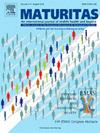Associations between the incidence of Fuchs' endothelial corneal dystrophy and menopausal hormone therapy use and exposure to endogenous estrogen
IF 3.9
2区 医学
Q2 GERIATRICS & GERONTOLOGY
引用次数: 0
Abstract
Objectives
End-stage Fuchs' endothelial corneal dystrophy is a leading cause of corneal blindness, with a higher prevalence in females than in males. Few modifiable risk factors have been identified. We examined associations between menopausal hormone therapy use (never/past/current), duration of hormone therapy use, estimated lifetime exposure to endogenous estrogen, and serum estradiol with incident Fuchs' endothelial corneal dystrophy in a cohort of postmenopausal women.
Study design
This was a prospective analysis in the Women's Health Initiative Observational Study.
Main outcome measures
Incident cases of Fuchs' endothelial corneal dystrophy were identified from the Women's Health Initiative Observational Study baseline (1993–1998) through 2019 using Medicare claims data.
Results
In 22,980 women, 1382 incident cases of Fuchs' endothelial corneal dystrophy (annualized incidence rate and 95 % confidence interval = 5.0 [4.8–5.3] cases per 1000 person-years) were identified. The adjusted hazard ratios and 95 % confidence intervals for Fuchs' endothelial corneal dystrophy were 1.02 (0.88–1.18) and 0.89 (0.79–0.997) for past and current hormone therapy use (vs. never use) at baseline, respectively. Adjusted hazard ratios (95 % confidence interval) were 0.90 (0.79–1.03) and 0.95 (0.84–1.08), p-trend = 0.36, for ≤10 and > 10 years, respectively, of hormone therapy use compared with no use; and the adjusted hazard ratio (95 % confidence interval) was 1.01 (0.88–1.15), p-trend = 0.87, for 46.7–59.0 versus 13.8–41.0 years of estimated lifetime exposure to endogenous estrogen. No statistically significant associations were observed with serum estradiol concentrations in a subset of participants.
Conclusions
In this cohort of postmenopausal women, current hormone therapy use (vs. never use) showed evidence of protection against the development of Fuchs' endothelial corneal dystrophy; however, duration of hormone therapy use, estimated lifetime exposure to endogenous estrogen, or serum estradiol concentrations were not significantly associated with a decreased risk of Fuchs' endothelial corneal dystrophy.
福氏内皮角膜营养不良症的发病率与更年期激素疗法的使用和内源性雌激素暴露之间的关系。
目的:终末期福氏角膜内皮营养不良症是角膜失明的主要原因,女性发病率高于男性。目前几乎没有发现可改变的风险因素。我们研究了绝经后妇女队列中更年期激素治疗使用(从未/过去/现在)、激素治疗使用持续时间、估计终生暴露于内源性雌激素和血清雌二醇与福氏角膜内皮营养不良发病率之间的关系:研究设计:这是妇女健康倡议观察研究中的一项前瞻性分析:利用医疗保险报销数据,从妇女健康倡议观察研究基线(1993-1998年)至2019年期间确定福氏内皮角膜营养不良的发病病例:结果:在22980名女性中,发现了1382例福克斯内皮角膜营养不良病例(年发病率和95%置信区间=每1000人年5.0 [4.8-5.3]例)。基线时曾使用和目前使用激素疗法(与从未使用激素疗法相比)的福氏内皮角膜营养不良调整后危险比和 95 % 置信区间分别为 1.02 (0.88-1.18) 和 0.89 (0.79-0.997)。与未使用激素疗法相比,使用激素疗法≤10年和>10年的调整后危险比(95%置信区间)分别为0.90(0.79-1.03)和0.95(0.84-1.08),p-趋势=0.36;估计终生接触内源性雌激素46.7-59.0年与13.8-41.0年的调整后危险比(95%置信区间)为1.01(0.88-1.15),p-趋势=0.87。在一部分参与者中,没有观察到与血清雌二醇浓度有统计学意义的关联:结论:在这批绝经后妇女中,目前使用激素疗法(与从未使用激素疗法相比)有证据表明可以预防福氏内皮角膜营养不良症的发生;但是,使用激素疗法的持续时间、估计终生暴露于内源性雌激素的时间或血清雌二醇浓度与福氏内皮角膜营养不良症风险的降低并无显著关联。
本文章由计算机程序翻译,如有差异,请以英文原文为准。
求助全文
约1分钟内获得全文
求助全文
来源期刊

Maturitas
医学-妇产科学
CiteScore
9.10
自引率
2.00%
发文量
142
审稿时长
40 days
期刊介绍:
Maturitas is an international multidisciplinary peer reviewed scientific journal of midlife health and beyond publishing original research, reviews, consensus statements and guidelines, and mini-reviews. The journal provides a forum for all aspects of postreproductive health in both genders ranging from basic science to health and social care.
Topic areas include:• Aging• Alternative and Complementary medicines• Arthritis and Bone Health• Cancer• Cardiovascular Health• Cognitive and Physical Functioning• Epidemiology, health and social care• Gynecology/ Reproductive Endocrinology• Nutrition/ Obesity Diabetes/ Metabolic Syndrome• Menopause, Ovarian Aging• Mental Health• Pharmacology• Sexuality• Quality of Life
 求助内容:
求助内容: 应助结果提醒方式:
应助结果提醒方式:


